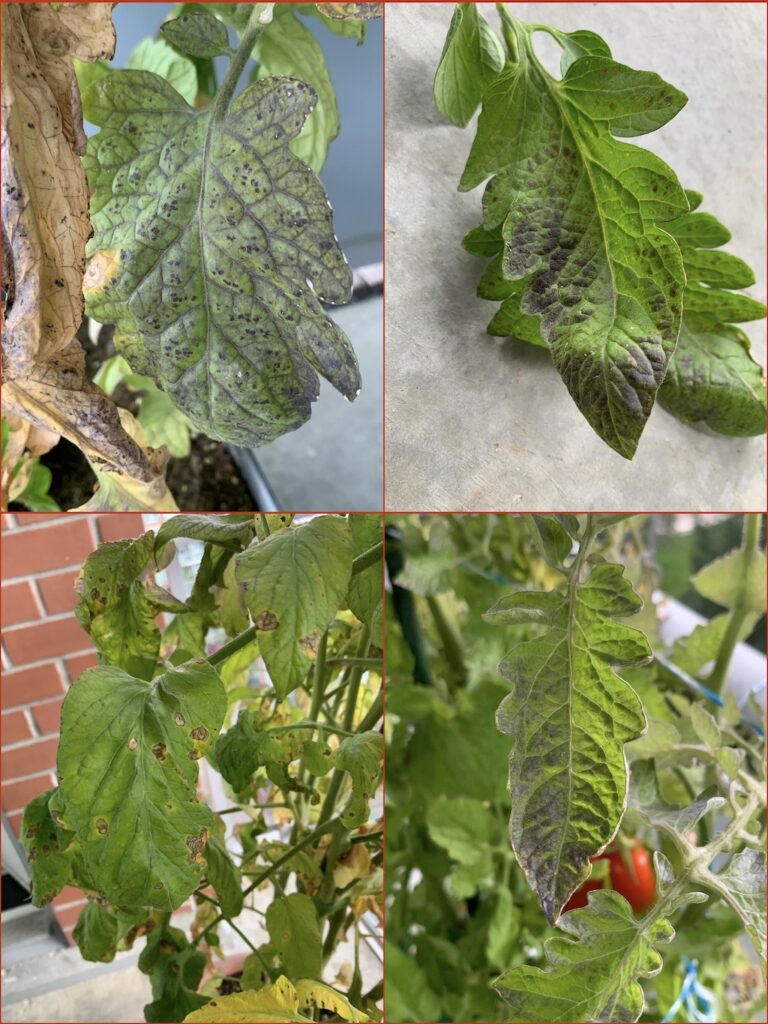
This summer, as with many years past, I nurtured three tomato plants on my south-facing balcony. Two were Roma tomatoes, and, for the first time, I experimented with growing an heirloom tomato (featured in the bottom left picture).
Around mid-summer, I noticed all three plants developing a dark purplish hue on some lower leaves, predominantly on the sun-facing side next to the glass balcony panels. The purplish color appeared as deep velvety in some instances and spotty in others, commencing notably with the lower leaves that I subsequently trimmed. Additionally, I observed some leaves displaying brown spots (refer to the lower left picture), which, I presume, could be indicative of another disease besides the dark coloring. The watering was well-regulated, ensuring proper drainage in their pots. The summer was relatively dry, leaving little chance for standing moisture or rain to settle on the leaves as the balcony is covered. However, a couple of heavy rain episodes did soak them briefly.
I sourced the plants, then about 4″ tall, from a local grocery store, nested them in fresh Miracle-Gro potting soil, and nourished them with vegetable fertilizer every 2-3 weeks starting from mid-June. The yield was substantial, but I was concerned as the foliage did not maintain its health throughout the season. While cleaning them up this week, I encountered numerous dead leaves, now turned black, but which were previously purple while growing.
I am keen to know what might have caused these issues and how I could have treated or possibly prevented them. I have disposed of the soil, but I’m wondering if there remains a risk of growing plants in the same area next year.
I appreciate any insights or advice you could offer. Thanks a lot!
Congratulations on a great tomato crop.
Purple leaves on tomato plants may be due to a number of things including nutrient deficiency (magnesium, phosphorus or potassium), pests (like psyllids) and diseases (like tomato purple leaf disorder), low soil temperature and intense light, especially on young tomato plants.
Given your reported plant care regime, the fact that you had a good tomato crop, and that on all three plants the dark purplish hue developed on lower leaves predominantly on the sun-facing side next to the glass balcony panels, I suspect that intense heat could be the main issue. Balcony environmental conditions can be quite severe in summer. You could use a cloth to block some of the sun and lower the light intensity during the sunniest part of the day. Or, you could move the plants away from the sunniest part of the balcony during the hottest part of the day.
The brown spots you observed on the leaves are likely caused by some sort of bacterial, fungal or viral disease. The specific one is not clear. Here are some tips for future growing seasons to help keep such diseases under control:
- Monitor your plants regularly. Act quickly to remove any affected leaves and throw them in the garbage.
- Disinfect any tools you have used on the plants before using them with other plants.
- Mulch the plants and stake them.
- Ensure there is adequate air circulation between the plants.
- Keep the leaves dry by watering only the soil, and not the leaves.
- Do not save seed from infected plants
For further information on management of leaf spot and prevention, please review the following website: Tomato leaf diseases

